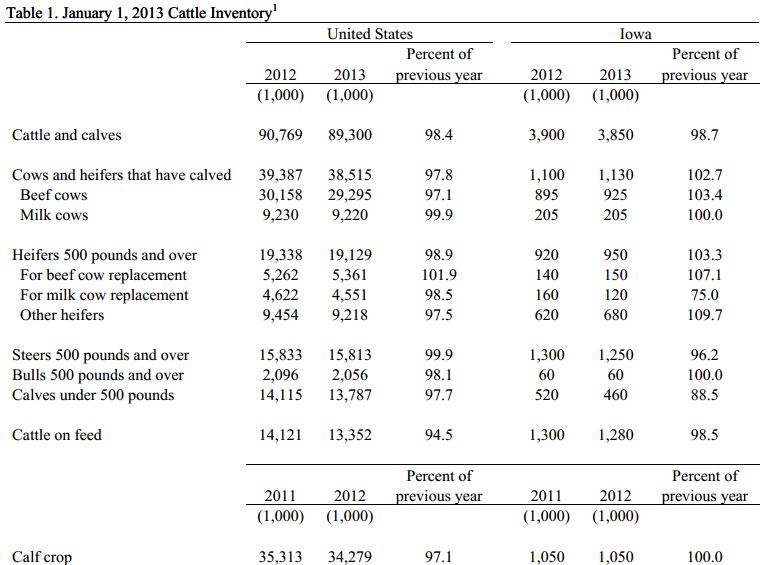



Cattle on Feed Down 6 per cent
US - The cattle on feed report, released on Friday, posts feedlot placements 6 per cent lower than last year at 11.1 million with placements (+2 per cent) and marketings (+6 per cent)for the January months higher than the same period last year.USDA has released the much anticipated January Cattle Inventory Report. Table 1 contains a summary of the report. The take-home contribution of the report was additional confirmation of shrinking national cattle supplies.
Most final estimates were within the range of pre-report expectations with a few exceptions (namely
the annual calf crop being down nearly 3 per cent and 3-state small grain pasture grazing supplies being down almost 16 per cent) generally suggesting future feeder cattle supplies may be even tighter than previously believed.
The report itself can be construed as moderately bullish for cattle prices in late-2013 and 2014. USDA has released the much anticipated January Cattle Inventory Report. Table 1 contains a summary of the report.
The take-home contribution of the report was additional confirmation of shrinking national cattle supplies.
Most final estimates were within the range of pre-report expectations with a few exceptions (namely the annual calf crop being down nearly 3 per cent and 3-state small grain pasture grazing supplies being down almost 16 per cent) generally suggesting future feeder cattle supplies may be even tighter than previously believed.
The report itself can be construed as moderately bullish for cattle prices in late-2013 and 2014.
U.S. Cattle Inventory
All cattle and calves in the U.S. as of January 1, 2013 totaled 89.30 head, a 1.6 per centdecrease from January 1,2012. This was the lowest January 1 inventory of all cattle and calves since the 88.10 million in 1952.
Beef cows totaled 29.30 million, a 2.9 per centdecrease from last year. The estimate for January 1, 2012 was increased by 275,000 with almost all of the revision in beef cow numbers coming in Oklahoma and Texas.
This suggests that herd liquidation in 2011 was not as severe as earlier estimated in those two states. However, Texas lost even more beef cows in 2012, down 12.0%, while Oklahoma beef cow numbers dropped a modest 1.3 per centin 2012.
The report suggests collectively cattlemen have been adding youth to their breeding stock as replacement heifers are up from last year while the national beef cow herd has declined reflecting ongoing culling.
Heifers for beef cow replacement totaled 5.36 million, a 1.9 per centincrease from last year. While heifer replacements are higher than estimates for 2011 and 2012, they remain lower than any other year since 1990 suggesting “real expansion” has yet to be initiated.
The recent year-over-year increase in heifers for beef cow replacement indicate, more than anything else, the contrast between what the industry would like to do compared to what they are able to do.
Drought and continued beef cow liquidation meant that a very low percentage of those potential replacement heifers actually entered the herd in 2012. As we look forward, it depends almost entirely on whether drought conditions moderate to determine what percentage of those heifers may actually enter the herd in 2013.
The total calf crop for 2012 was 34.28 million, 2.9 per centlower than a year ago. This was the lowest annual calf crop since 1949. The smaller calf crop implies a net reduction in the number of cattle that will come to market in late-2013 and in 2014 and hence a moderately bullish forecast for cattle prices in late-2013 and 2014.
The total cattle on feed inventory was estimated at 13.35 million, 5.5 per centlower than a year ago. It only happens twice a year that we get the total cattle on feed inventory and the monthly cattle on feed inventory (1,000+ head capacity).
The monthly inventory down 5.6%, compared to the semi-annual inventory down 5.5 per centfrom a year
ago, suggests some of the exiting and downsizing by smaller feedlots that was speculated to have occurred this past year may be slowing. However, without continued reductions in feedlot inventories, the feeder supply will continue to shrink.
And, if conditions permit, increased heifer retention will further squeeze feeder supplies in
the coming years.
TheCattleSite News Desk



